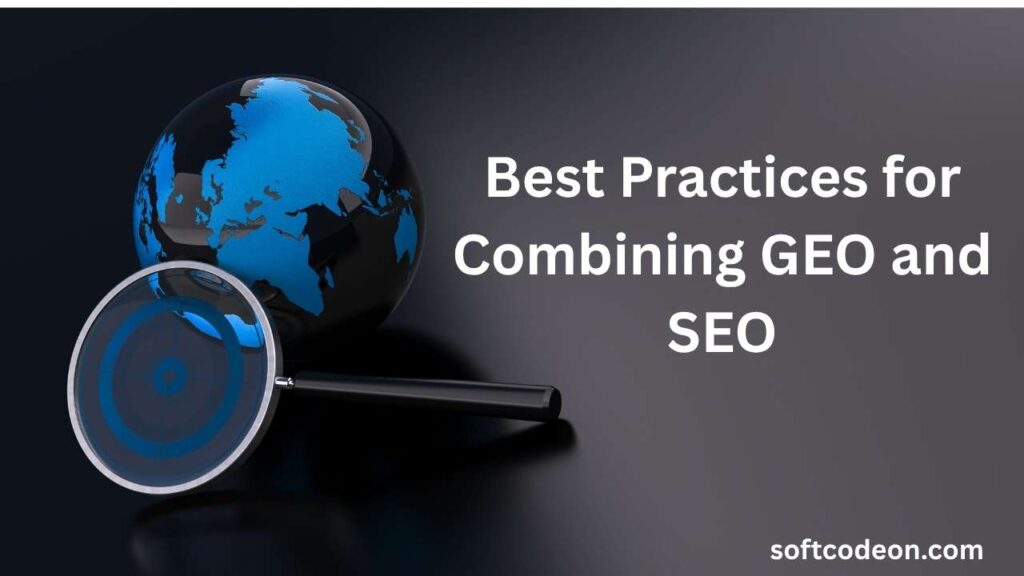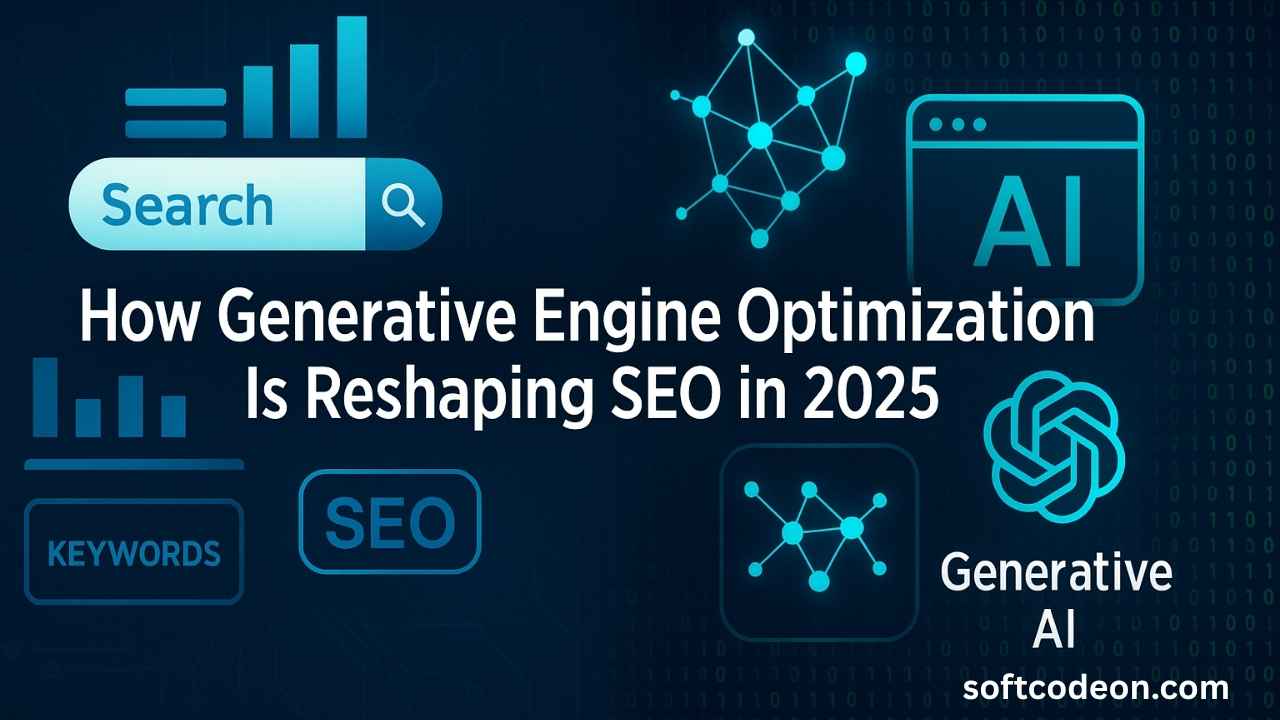As digital marketing continues to evolve, two powerful strategies are gaining attention: GEO (Generative Engine Optimization) and the long established SEO (Search Engine Optimization). While SEO has helped businesses and creators improve their visibility on traditional search engines like Google for years, a new shift is underway. With the rise of AI-powered platforms like ChatGPT, Google SGE, and Perplexity AI, GEO is emerging as a crucial factor in how content is discovered, understood, and delivered in this new era of generative search.
Understanding both GEO and SEO is essential for anyone looking to stay ahead in the digital world. In this article, we’ll explore what each term means, how they differ, and how you can optimize your content for both traditional and generative search systems.
What is SEO (Search Engine Optimization)?

Search Engine Optimization (SEO) is the practice of optimizing web content so that it ranks higher in search engine results pages (SERPs). It’s been the cornerstone of digital marketing for over two decades.
Key SEO Techniques Include:
- Keyword Research: Finding relevant search terms that users frequently type into search engines.
- On-Page SEO: Optimizing title tags, meta descriptions, headers, and image alt text are included in Onpage SEO.

- Content Optimization: Writing valuable and original content that answers users’ search queries.
- Technical SEO: Ensuring fast loading speeds, mobile-friendliness, and proper indexing.
- Backlinks: Earning links from reputable websites to boost domain authority.
- User Experience (UX): Ensuring smooth navigation and high engagement.
SEO is about making content visible to Google’s bots and, by extension, to the users who search for information.
What is GEO (Generative Engine Optimization)?
Generative Engine Optimization (GEO) is the process of optimizing your content so that it gets picked up, referenced, or summarized by generative AI tools like ChatGPT, Google SGE (Search Generative Experience), and other LLM-powered engines.

Unlike traditional SEO, GEO is not about ranking higher in a list. It’s about being selected by AI systems to provide direct answers, summaries, or suggestions to users.
How GEO Works:
- When a user asks a generative AI a question (e.g., “What are the benefits of a plant-based diet?”), the AI searches its training data or performs a live web search.
- It summarizes or pulls information from various sources blogs, articles, research papers to form a response.
- If your content is authoritative, well-structured, and informative, it may be included in the AI’s output.
GEO is about being present in the answers, not just in the links.
GEO vs SEO: Key Differences
Let’s look at a comparison between the two approaches:
| Aspect | SEO (Search Engine Optimization) | GEO (Generative Engine Optimization) |
|---|---|---|
| Goal | Rank high on search engine result pages (SERPs) | Be referenced or quoted in AI-generated responses |
| Audience | Human users browsing SERPs | AI systems generating answers for human users |
| Optimization Focus | Keywords, metadata, backlinks | Clarity, authority, semantic richness, up-to-date content |
| Measurement | Click-through rate, rankings, bounce rate | Inclusion in AI responses, citations, prompt relevance |
| Tools | Google Search Console, Ahrefs, SEMrush | Perplexity AI, Google SGE, ChatGPT citations |
| Content Type | Long-form articles, listicles, landing pages | Concise, structured, clear explanations |
| Indexing & Crawling | Web crawler bots | LLM (Large Language Model) training + live crawl |
| Monetization Impact | Drives traffic to your site | May reduce clicks but boost authority via mentions |
Why is GEO the Future?
Generative AI engines are changing how people search for information. Instead of clicking through multiple links, users are getting instant summaries and direct answers. This is especially true for mobile users and professionals who want quick insights.
However, SEO is still vital:
- Traditional search engines are still widely used.
- AI systems often pull data from well-ranked SEO-optimized pages.
- You still need traffic, conversions, and on-site engagement.
In short, GEO is not replacing SEO it’s building on top of it.
Best Practices for Combining GEO and SEO
To succeed in the modern content landscape, you can no longer rely on traditional SEO strategies alone. Instead, you must think about how both Search Engines and Generative AI Engines interpret your content. This means creating content that ranks well on Google and gets referenced or summarized by AI tools like ChatGPT, Perplexity, and Google SGE. Here are the key best practices for balancing both worlds effectively:

1. Write with Clarity and Authority
Clear writing is essential not only for human readers but also for generative engines. Large language models (LLMs) like ChatGPT look for content that is well-structured, factually accurate, and easy to digest. Avoid using overly complex or industry-specific jargon unless it’s necessary for your target audience. Even then, define it clearly.
For instance, instead of writing:
“Citrus limon aids gastrointestinal motility,”
say:
“Lemon water helps your digestive system work more smoothly.”
At the same time, authoritativeness matters. AI tools tend to favor sources that display expertise. Use your knowledge or credentials to explain topics in a way that builds trust with both the reader and the AI model.
2. Use Structured Content for Easy Parsing
Generative engines love content that is organized and easy to parse. By breaking your content into clearly labeled sections with headings (H2, H3), bullet points, numbered lists, and short paragraphs you increase the chance that the AI will be able to extract meaningful information for summaries.
For example:
- Use headings like “Benefits of Drinking Lemon Water”
- Use bullet points to list out benefits
- Insert quick definitions or takeaway boxes
This structure makes your content more readable and improves its chances of being cited or quoted by AI. Remember, AI models often pull just a snippet or paragraph, so make every section concise and meaningful.
3. Keep Your Content Fresh, Updated, and Relevant
Generative engines prefer up-to-date information. AI tools like Google’s Search Generative Experience (SGE) may prioritize content published or updated recently, especially when it involves topics in fast-changing industries like health, finance, or technology.
Maintain a habit of:
- Regularly revisiting older articles to update stats or outdated references
- Adding recent news or developments to keep content fresh
- Rewriting or republishing evergreen posts with a new angle or updated intro
Updated content doesn’t just help with GEO Google also considers freshness a ranking factor in traditional SEO.
4. Build E-E-A-T (Experience, Expertise, Authoritativeness, Trustworthiness)
One of the most important principles of SEO and now GEO is E-E-A-T. Both Google and AI models look for content that demonstrates real-world experience and trustworthiness.
To optimize for E-E-A-T:
- Add author bios to your content pages
- Mention your credentials or industry experience (e.g., “Certified nutritionist” or “10+ years in digital marketing”)
- Use citations from trusted sources like government websites (.gov), research databases, or recognized industry leaders
- Ensure your content is factual and accurate
When AI tools see that your content is written by a trustworthy source, they’re more likely to include it in their responses.
5. Use Semantic SEO and Topic Clusters
SEO has moved beyond exact-match keywords. Today, semantic SEO is crucial and it aligns well with how AI models interpret content. Semantic SEO focuses on the context and meaning behind words, not just matching phrases.
This means:
- Writing naturally and covering related subtopics in-depth
- Using synonyms, related phrases, and LSI (Latent Semantic Indexing) keywords
- Building topic clusters (e.g., a pillar page on “Digital Marketing” linking to sub-articles like “Email Marketing”, “Social Media Ads”, “SEO Basics”, etc.)
Semantic-rich content helps search engines understand what your page is about and helps AI engines generate well-rounded, informed answers that are more likely to include your content.
6. Monitor and Analyze AI Citations
Just like checking your rankings on Google, you should also check if AI engines are referencing your content. Tools like Perplexity AI provide direct citations. Google’s SGE and some AI assistants also include source mentions below the generated answers.
To take advantage of this:
- Perform searches on tools like ChatGPT (with browsing), Bing Chat, or Perplexity using your target queries
- Look at what types of sources they pull into their responses
- Study the structure and tone of the content that is getting cited
Once you understand what gets picked, adjust your content accordingly. This will help you optimize specifically for Generative Engine Optimization.
7. Balance Keyword Optimization with Natural Language
While keywords are still important for SEO, generative engines rely more on understanding user intent and natural language. Focus on creating content that answers questions in a conversational tone. Instead of stuffing keywords, use them organically.
For instance:
- Instead of repeating “best SEO tools 2025” ten times, use variants like “top SEO platforms,” “popular search optimization tools,” or “tools for better Google rankings.”
- Answer questions that people actually ask use tools like AnswerThePublic, People Also Ask, or Reddit to find common queries.
The goal is to create content that is both findable by search engines and usable by AI systems to answer real questions effectively.
Conclusion
The rise of Generative Engine Optimization (GEO) doesn’t mean the death of Search Engine Optimization (SEO). Instead, it signals a shift in how content is consumed and how brands should adapt. While SEO helps you get found by search engines, GEO helps you get featured by AI.
In 2025 and beyond, the smartest marketers will master both SEO and GEO ensuring their content is not only found but also trusted, referenced, and summarized by both humans and machines.
Start today. Optimize not just for search, but for answers.

